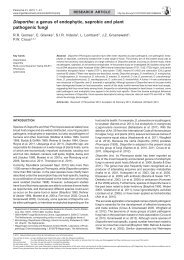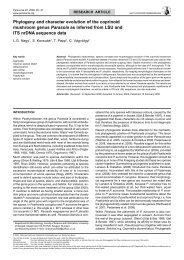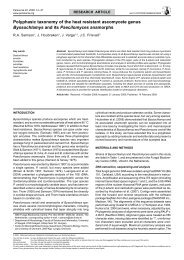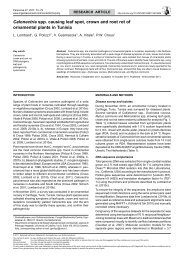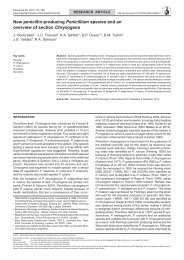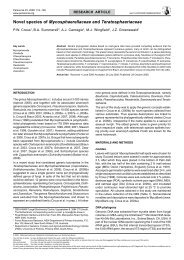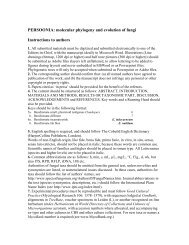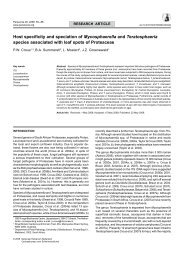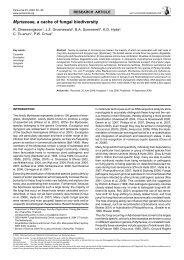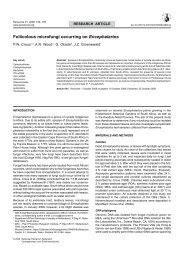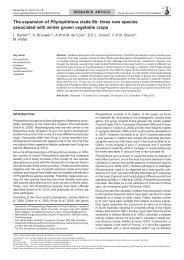Phylogeny and taxonomy of obscure genera of microfungi - Persoonia
Phylogeny and taxonomy of obscure genera of microfungi - Persoonia
Phylogeny and taxonomy of obscure genera of microfungi - Persoonia
Create successful ePaper yourself
Turn your PDF publications into a flip-book with our unique Google optimized e-Paper software.
P.W. Crous et al.: Obscure <strong>genera</strong> <strong>of</strong> micr<strong>of</strong>ungi<br />
149<br />
a<br />
b<br />
c<br />
d<br />
e<br />
f<br />
g h i j<br />
Fig. 8 Cyphellophora eugeniae (CBS 124105). a, b. Colonies sporulating on OA; c–e. conidia attached to conidiogenous cells (arrows denote loci); f–j.<br />
conidia. — Scale bars = 10 µm.<br />
finely guttulate, 4–6(–10)-septate, prominently constricted at<br />
septa, widest in the middle <strong>of</strong> conidium, (40–)60–75(–90) ×<br />
2–2.5(–3) µm; conidia also anastomose <strong>and</strong> undergo microcyclic<br />
conidiation in culture.<br />
Characteristics in culture — Colonies on PDA erumpent,<br />
with sparse aerial mycelium <strong>and</strong> even margins; surface olivaceous-grey,<br />
with patches <strong>of</strong> iron-grey; reverse iron-grey. On<br />
MEA erumpent, with folded surface <strong>and</strong> smooth, lobate margin,<br />
<strong>and</strong> sparse aerial mycelium; surface pale olivaceous-grey to<br />
olivaceous-grey; reverse iron-grey. On OA spreading, flat, with<br />
even, smooth margins <strong>and</strong> sparse aerial mycelium, olivaceousgrey.<br />
Colonies reaching 15 mm diam after 1 mo at 25 °C, fertile,<br />
sporulating in slimy sporodochial masses.<br />
Specimen examined. Brazil, Rio Gr<strong>and</strong>e do Sul, Guaiba, living leaves <strong>of</strong><br />
Stenocalyx uniflorus, 1 Apr. 2008, leg. A.C. Alfenas, isol. P.W. Crous, holotype<br />
CBS H-20201, culture ex-type CPC 15172 = CBS 124105.<br />
Notes — The indistinct conidiogenous loci <strong>of</strong> C. eugeniae are<br />
reminiscent <strong>of</strong> those <strong>of</strong> C. taiwanensis (Matsushima 1985). The<br />
two species can be distinguished by the much longer conidia in<br />
C. eugeniae. Based on the key provided by Decock et al. (2003),<br />
C. eugeniae appears to represent a new species. Further collections<br />
<strong>of</strong> this complex are required to confirm the synonymy<br />
<strong>of</strong> the <strong>genera</strong> Cyphellophora with Pseudomicrodochium <strong>and</strong><br />
Kumbhayama (Decock et al. 2003, Crous et al. 2007b), which<br />
were originally distinguished based on the absence <strong>of</strong> conidial<br />
pigmentation. The ITS sequence <strong>of</strong> C. eugeniae has 89 %<br />
similarity to that <strong>of</strong> Cyphellophora hylomeconis (GenBank accession<br />
EU035415).



